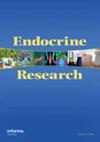The Vagus Nerve and the Celiaco-mesenteric Ganglia Participate in the Feeding Responses Evoked by Non-sulfated Cholecystokinin-8 in Male Sprague Dawley Rats
IF 1.5
4区 医学
Q4 ENDOCRINOLOGY & METABOLISM
引用次数: 0
Abstract
ABSTRACT We have shown that non-sulfated cholecystokinin-8 (NS CCK-8) reduces food intake in adult male Sprague Dawley rats by activating cholecystokinin-B receptor (CCK-BR). Here, we tested the hypothesis that the vagus nerve and the celiaco-mesenteric ganglia may play a role in this reduction. The hypothesis stems from the following facts. The vagus and the celiaco-mesenteric ganglia contain NS CCK-8, they express and have binding sites for CCK-BR, NS CCK-8 activates CCK-BR on afferent vagal and sympathetic fibers and the two structures link the gastrointestinal tract to central feeding nuclei in the brain, which also contain the peptide and CCK-BR. To test this hypothesis, three groups of free-feeding rats, vagotomy (VGX), celiaco-mesenteric ganglionectomy (CMGX) and sham-operated, received NS CCK-8 (0, 0.5 and 1 nmol/kg) intraperitoneally prior to the onset of the dark cycle and various feeding behaviors were recorded. We found that in sham-operated rats both doses of NS CCK-8 reduced meal size (MS), prolonged the intermeal interval (IMI, time between first and second meal), increased satiety ratio (SR = IMI/MS), reduced 24-h food intake and reduced the number of meals relative to saline control. In the VGX and the CMGX groups, all of the previous responses were attenuated. Consistent with our hypothesis, the findings of the current work suggest a role for the vagus nerve and the celiaco-mesenteric ganglia in the feeding responses evoked by NS CCK-8.迷走神经和腹腔-肠系膜神经节参与非硫酸化胆囊收缩素-8诱导的雄性大鼠摄食反应
摘要我们已经发现,非硫酸化胆囊收缩素-8(NS CCK-8)通过激活胆囊收收缩素-B受体(CCK-BR)来减少成年雄性Sprague-Dawley大鼠的食物摄入。在这里,我们检验了迷走神经和腹腔-肠系膜神经节可能在这种减少中发挥作用的假设。这个假设源于以下事实。迷走神经和腹腔-肠系膜神经节含有NS CCK-8,它们表达并具有CCK-BR的结合位点,NS CCK-8激活传入迷走神经和交感纤维上的CCK-BR,这两个结构将胃肠道连接到大脑中的中央进食核,其中也含有肽和CCK-BR。为了验证这一假设,三组自由喂养大鼠,迷走神经切断术(VGX)、腹腔-肠系膜神经节切除术(CMGX)和假手术,在暗周期开始前腹膜内接受NS CCK-8(0、0.5和1nmol/kg),并记录各种喂养行为。我们发现,在假手术大鼠中,与生理盐水对照相比,两种剂量的NS CCK-8都减少了食量(MS),延长了餐间间隔(IMI,第一次和第二次用餐之间的时间),增加了饱腹率(SR=IMI/MS),减少了24小时的食物摄入,并减少了用餐次数。在VGX和CMGX组中,所有先前的反应都减弱了。与我们的假设一致,目前的研究结果表明迷走神经和腹腔-肠系膜神经节在NS CCK-8引起的进食反应中发挥作用。
本文章由计算机程序翻译,如有差异,请以英文原文为准。
求助全文
约1分钟内获得全文
求助全文
来源期刊

Endocrine Research
医学-内分泌学与代谢
CiteScore
4.30
自引率
0.00%
发文量
10
审稿时长
>12 weeks
期刊介绍:
This journal publishes original articles relating to endocrinology in the broadest context. Subjects of interest include: receptors and mechanism of action of hormones, methodological advances in the detection and measurement of hormones; structure and chemical properties of hormones. Invitations to submit Brief Reviews are issued to specific authors by the Editors.
 求助内容:
求助内容: 应助结果提醒方式:
应助结果提醒方式:


